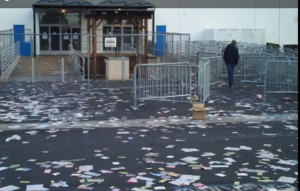My interest in Jim Jones and Jonestown began when I stumbled across an mp3 file of the “Death Tape“ (Q042) on the internet while I was an undergraduate working at the California State University of San Bernardino. While I had no initial inclination of developing my interest in the tape into my art, I was immediately fascinated with it and its existence. I believe my fascination in the recording was not just in its historical significance but in its powerfully transcendent qualities.
About a year later, I began working on an installation project to be displayed at a show in Santa Monica. The installation was based on my teenage experiences with what are popularly referred to as rave parties. I began to explore what can be described as the “aftermath” of these events. Generally, this includes a vacant parking lot adjacent to the fringe location that these parties occupy. The parking lots are typically heavily littered with the ephemera of the event: discarded flyers advertising upcoming parties, glow sticks, cigarettes, etc.
One theme about these rave parties that I found great interest in was the idea of them acting as places of escape or places of temporary grasps at utopia for the attendants. I began shooting videos of these places to project into the installation I was working on. I began to consider other ideas of utopias and their aftermaths, which eventually lead me back to Jonestown, Guyana. While further researching Jonestown, I discovered the amount of reclaimed audio that was available at this website.
The parallels I began to make between the failed utopias struck me as significant as I discovered in my research that there were musical recordings recovered from the Jonestown site as well. Upon request and receipt of the recordings, I went through them looking for audio to combine with the visuals I had captured. The music recorded at Jonestown by some of the members of Peoples Temple was indeed haunting, but beyond that it was hopeful, bright, and beautiful, a fascinating paradox considering the horrific events that came to define the now general perception of Jonestown.
The music served as a bridge to the humanity of Jonestown for me. It helped create a personal and intimate connection with Jonestown that I could not have developed with any written article that I might have read during my research. Beyond using the audio to further direct the themes in my work, it also helped create a personal relationship with the viewers of my work. Music will always have an uncanny way of capturing and uniting an audience while providing them with brief moments of total escape and bliss, a concept I’m sure was not lost on the people of Jonestown.
(Andy Brown may be contacted at andy_brown032000@yahoo.com.)
